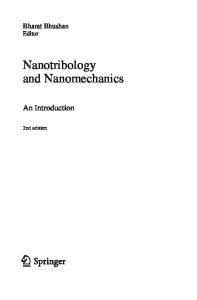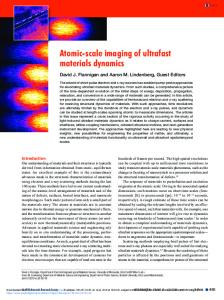Towards the Synthesis of Atomic Scale Wires
- PDF / 317,376 Bytes
- 6 Pages / 414.72 x 648 pts Page_size
- 55 Downloads / 281 Views
P. A. ANDERSON,* L. J. WOODALL,* A. PORCH,** A. R. ARMSTRONG,*t I. HUSSAIN,* AND P. P. EDWARDS* *School of Chemistry, University of Birmingham, Edgbaston, Birmingham, B15 2TT, U.K. **School of Electronic and Electrical Engineering, University of Birmingham, Edgbaston, Birmingham, B 15 2TT, U. K. tCurrent address: School of Chemistry, University of St. Andrews, Fife, KY16 9ST, U.K.
ABSTRACT Recent work1 has highlighted the possibility that through the introduction of metals into the one-dimensional channels of zeolite L, it may be feasible to engineer charge transport along the channels to produce a unique compound comprising a precise, assembled array of ultrafine, atomic-scale conducting wires embedded within the aluminosilicate framework. Using electron spin resonance (ESR), and microwave cavity perturbation measurements, we examine the properties of these remarkable materials as a function of composition as they approach the insulator to metal transition.
INTRODUCTION The class of crystalline aluminosilicates known as zeolites, many of which are naturally occurring minerals, are composed of corner-sharing Si0 4 and A10 4 tetrahedra, arranged into three-dimensional frameworks in such a manner that they contain regular channels and cavities of molecular dimensions (Figure 1). Conventionally a metal is often described as a regular array of ions embedded in a sea of itinerant electrons. Although neither exists in practice, a close approximation to the former is a dehydrated zeolite such as zeolite L, where cations coordinated on only one side to an anionic framework, line the inside of a series of regular channels. The controlled and continuous doping of 'excess electrons' into these white insulating solids is possible through their reaction with alkali metal vapour. Incoming metal atoms are ionized by the intense electric fields within the zeolite releasing electrons to interact with the zeolite cations.1- 6 We have noted that at some critical stage of metal loading, one expects 8 enhanced electron-electron interactions and the possibility of an insulator-metal transition.6The purpose of this study is to examine the conductivity of these metal-loaded zeolites as a function of potassium concentration and determine whether the conduction mechanism is metallic. Since the samples are both air- and moisture-sensitive, and in powder form, a contactless conductivity measurement is preferred. A convenient method for studying the conductivity of such samples is the microwave cavity perturbation technique, where dissipative eddy currents can be set up within each powder grain. 9 This dissipation is readily
Mat. Res. Soc. Symp. Proc. Vol. 384 01995 Materials Research Society
Figure 1. Representation of zeolite L with potassium metal atoms occupying the channels.
sample in quartz tube (placed in max. B field)
,magnetic field lines
_U L S
.flcoaxial
coupling
(loop)
4 quarter wave resonator
"stripline
4 mm Figure 2. Schematic diagram of the 3.5 GHz copper hairpin resonator.
10
assessed from the resonant bandwidt
Data Loading...









